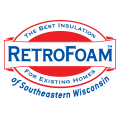RetroFoam FAQ’s

Answering the Most Common Questions About RetroFoam
What is RetroFoam?
RetroFoam is a tripolymer based resin that creates an odor-free, non-toxic foam insulation.
This injection foam doesn’t off-gas, is Class One Fire Rated, and safe to have in your home.
What is the difference between injection foam and spray foam?
It comes down to how both are installed.
Spray foam is sprayed into open cavities like attics, crawl spaces, and rim joists, while injection foam, like RetroFoam insulation, is injected into enclosed cavities like walls.
How much money can I save on energy bills?
The amount you save on monthly energy bills can vary depending on your home’s age and construction.
Your lifestyle can also play a role, depending on your thermostat settings and your electrical usage.
Does RetroFoam insulation reduce noise transmission?
Sound deadening is an added bonus of RetroFoam insulation.
While injection foam won’t completely soundproof your home, it will help make it a little quieter.
Can you fish wires through RetroFoam if the electrical needs work?
You sure can!
RetroFoam is soft and pliable, which means you won’t have any trouble fishing wires through it.
Can I insulate just one problem wall?
You can, but there is a bigger picture to consider.
You always want to look at your home like an entire system. If you focus on just one wall, you’ll likely not get the results you want.
How will my home’s exterior affect the installation process?
The processes for aluminum and vinyl, brick, and wood are all different.
Our team will explain the process in detail to you after evaluating your home.
How do you know when the wall cavity is full?
Our RetroFoam installers have been specially trained to ensure the wall cavity is completely filled.
This training includes running the hose from the top of the cavity down to the middle and then from the middle up. This method ensures the foam fills all of the nooks and crannies in the wall cavity.
Can RetroFoam be installed from the inside?
Yes, it can.
It can be a little messy, as the installation crew will be drilling into the drywall, but they also make sure to cover all surfaces and clean up after themselves.
Can the interior drywall pop, crack, or bow during installation?
While rare, this can happen.
It’s important to address your concerns with your estimator or project manager so you can make sure you are both on the same page on what will happen if this occurs.
Should I insulate the wall between my home and attached garage?
Yes, you should because that can be a source of air leakage, especially if your garage isn’t insulated.
What happens to the old fiberglass in the walls?
When RetroFoam is injected into the walls, the old fiberglass is compressed as it fills in every nook and cranny in the cavity.
Take the Next Step Towards Comfort and Energy Efficiency
Contact us to schedule your free estimate today.
